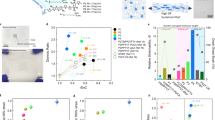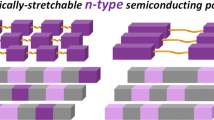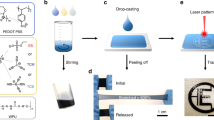Abstract
For the development of wearable and stretchable devices, insights into the mechanical properties and structural deformation of functional conjugated polymers are required. In particular, polythiophene has received much attention as a typical hole transfer material in electronic devices. However, the widely accepted polythiophenes are brittle because of the rigid chemical structure of thiophene rings. We have reported on the synthesis and flexible properties of polythiophene with disiloxane groups in side chains, and it was revealed that the polythiophene exhibited greater than 200% elongation at break at room temperature. In this study, we investigated the deformation process of polythiophene through in situ measurements under stretching using X-ray diffraction of synchrotron radiation and polarized infrared spectroscopy. In the X-ray diffraction measurements, orientation of the crystallites occurred after yielding, while the relative intensities of the polarized infrared absorption bands gradually increased during stretching. As seen from these results, during the initial deformation, the polythiophene chains in the amorphous region were aligned, and then, the whole bulk of the polythiophene, including crystallites and amorphous regions, were oriented after yielding. We succeeded in tracing the structural deformation of polythiophene during stretching.
This is a preview of subscription content, access via your institution
Access options
Subscribe to this journal
Receive 12 print issues and online access
$259.00 per year
only $21.58 per issue
Buy this article
- Purchase on Springer Link
- Instant access to full article PDF
Prices may be subject to local taxes which are calculated during checkout




Similar content being viewed by others
References
Docampo P, Ball JM, Darwich M, Eperon GE, Snaith HJ. Efficient organometal trihalide perovskite planar-heterojunction solar cells on flexible polymer substrates. Nat Commun. 2013;4:2761.
Li Y. Molecular design of photovoltaic materials for polymer solar cells: toward suitable electronic energy levels and broad absorption. Acc Chem Res. 2012;45:723–33.
Li G, Zhu R, Yang Y. Polymer solar cells. Nat Phot. 2012;6:153–61.
Forrest SR. The path to ubiquitous and low-cost organic electronic appliances on plastic. Nature. 2004;428:911–8.
Sirringhaus H. Device physics of solution-processed organic field-effect transistors. Adv Mater. 2005;17:2411–25.
Kim D-H, Ahn J-H, Choi WM, Kim H-S, Kim T-H, Song J, et al. Stretchable and foldable silicon integrated circuits. Science. 2008;320:507 LP–511.
Han T-H, Lee Y, Choi M-R, Woo S-H, Bae S-H, Hong BH, et al. Extremely efficient flexible organic light-emitting diodes with modified graphene anode. Nat Photonics. 2012;6:105.
Dai X, Zhang Z, Jin Y, Niu Y, Cao H, Liang X, et al. Solution-processed, high-performance light-emitting diodes based on quantum dots. Nature. 2014;515:96.
Cao Q, Rogers JA. Ultrathin films of single-walled carbon nanotubes for electronics and sensors: a review of fundamental and applied aspects. Adv Mater. 2009;21:29–53.
Guimard NK, Gomez N, Schmidt CE. Conducting polymers in biomedical engineering. Prog Polym Sci. 2007;32:876–921.
Kudo H, Sawada T, Kazawa E, Yoshida H, Iwasaki Y, Mitsubayashi K. A flexible and wearable glucose sensor based on functional polymers with Soft-MEMS techniques. Biosens Bioelectron. 2006;22:558–62.
Dang Z-M, Yuan J-K, Yao S-H, Liao R-J. Flexible nanodielectric materials with high permittivity for power energy storage. Adv Mater. 2013;25:6334–65.
Meng C, Liu C, Chen L, Hu C, Fan S. Highly flexible and all-solid-state paperlike polymer supercapacitors. Nano Lett. 2010;10:4025–31.
Simon P, Gogotsi Y. Materials for electrochemical capacitors. Nat Mater. 2008;7:845.
Sup Choi M, Lee G-H, Yu Y-J, Lee D-Y, Hwan Lee S, Kim P, et al. Controlled charge trapping by molybdenum disulphide and graphene in ultrathin heterostructured memory devices. Nat Commun. 2013;4:1624.
Bertolazzi S, Krasnozhon D, Kis A. Nonvolatile memory cells based on MoS2/graphene heterostructures. ACS Nano. 2013;7:3246–52.
Sekitani T, Yokota T, Zschieschang U, Klauk H, Bauer S, Takeuchi K, et al. Organic nonvolatile memory transistors for flexible sensor arrays. Science. 2009;326:1516 LP–1519.
Mannsfeld SCB, Tee BC-K, Stoltenberg RM, Chen CVH-H, Barman S, Muir BVO, et al. Highly sensitive flexible pressure sensors with microstructured rubber dielectric layers. Nat Mater. 2010;9:859.
Choi M-C, Kim Y, Ha C-S. Polymers for flexible displays: from material selection to device applications. Prog Polym Sci. 2008;33:581–630.
Patel S, Park H, Bonato P, Chan L, Rodgers M. A review of wearable sensors and systems with application in rehabilitation. J Neuroeng Rehabil. 2012;9:21.
Vashi S, Ram J, Modi J, Verma S, Prakash C. Internet of Things (IoT): A vision, architectural elements, and security issues In 2017 International Conference on I-SMAC (IoT in Social, Mobile, Analytics and Cloud) (I-SMAC). 2017, pp. 492–6.
Gubbi J, Buyya R, Marusic S, Palaniswami M. Internet of things (IoT): a vision, architectural elements, and future directions. Futur Gener Comput Syst. 2013;29:1645–60.
Kim KS, Zhao Y, Jang H, Lee SY, Kim JM, Kim KS, et al. Large-scale pattern growth of graphene films for stretchable transparent electrodes. Nature. 2009;457:706.
Jiang J, Li Y, Liu J, Huang X, Yuan C, (David) Lou XW. Recent advances in metal oxide-based electrode architecture design for electrochemical energy storage. Adv Mater. 2012;24:5166–80.
Gong S, Schwalb W, Wang Y, Chen Y, Tang Y, Si J, et al. A wearable and highly sensitive pressure sensor with ultrathin gold nanowires. Nat Commun. 2014;5:3132.
Park M, Im J, Shin M, Min Y, Park J, Cho H, et al. Highly stretchable electric circuits from a composite material of silver nanoparticles and elastomeric fibres. Nat Nano. 2012;7:803–9.
Koerner H, Price G, Pearce NA, Alexander M, Vaia RA. Remotely actuated polymer nanocomposites—stress-recovery of carbon-nanotube-filled thermoplastic elastomers. Nat Mater. 2004;3:115–20.
Cao J, Lu C, Zhuang J, Liu M, Zhang X, Yu Y, et al. Multiple hydrogen bonding enables the self-healing of sensors for human–machine interactions. Angew Chem Int Ed. 2017;56:8795–800.
Gray DS, Tien J, Chen CS. High-conductivity elastomeric electronics. Adv Mater. 2004;16:393–7.
Rosset S, Shea HR. Flexible and stretchable electrodes for dielectric elastomer actuators. Appl Phys A. 2013;110:281–307.
Lacour SP, Benmerah S, Tarte E, FitzGerald J, Serra J, McMahon S, et al. Flexible and stretchable micro-electrodes for in vitro and in vivo neural interfaces. Med Biol Eng Comput. 2010;48:945–54.
Choong C-L, Shim M-B, Lee B-S, Jeon S, Ko D-S, Kang T-H, et al. Highly stretchable resistive pressure sensors using a conductive elastomeric composite on a micropyramid array. Adv Mater. 2014;26:3451–8.
Wang G-JN, Gasperini A, Bao Z. Stretchable polymer semiconductors for plastic electronics. Adv Electron Mater. 2018;4:1700429.
Root SE, Savagatrup S, Printz AD, Rodriquez D, Lipomi DJ. Mechanical properties of organic semiconductors for stretchable, highly flexible, and mechanically robust electronics. Chem Rev. 2017;117:6467–99.
Fujita K, Sumino Y, Ide K, Tamba S, Shono K, Shen J, et al. Synthesis of poly(3-substituted thiophene)s of remarkably high solubility in hydrocarbon via nickel-catalyzed deprotonative cross-coupling polycondensation. Macromolecules. 2016;49:1259–69.
Shen J, Fujita K, Matsumoto T, Hongo C, Misaki M, Ishida K, et al. Mechanical, thermal, and electrical properties of flexible polythiophene with disiloxane side chains. Macromol Chem Phys. 2017;218:1700197.
Shen J, Sugimoto I, Matsumoto T, Horike S, Koshiba Y, Ishida K, et al. Fabrication and characterization of elastomeric semiconductive thiophene polymers by peroxide crosslinking. Polym J. 2019;51:257–63.
Higashihara T, Fukuta S, Ochiai Y, Sekine T, Chino K, Koganezawa T, et al. Synthesis and deformable hierarchical nanostructure of intrinsically stretchable ABA triblock copolymer composed of poly(3-hexylthiophene) and polyisobutylene segments. ACS Appl Polym Mater. 2019;1:315–20.
Higashihara T, Ito S, Fukuta S, Miyane S, Ochiai Y, Ishizone T, et al. Synthesis and characterization of multicomponent ABC- and ABCD-type miktoarm star-branched polymers containing a poly(3-hexylthiophene) segment. ACS Macro Lett. 2016;5:631–5.
Miyane S, Wen H-F, Chen W-C, Higashihara T. Synthesis of block copolymers comprised of poly(3-hexylthiophene) segment with trisiloxane side chains and their application to organic thin film transistor. J Polym Sci Part A Polym Chem. 2018;56:1787–94.
Mei J, Kim DH, Ayzner AL, Toney MF, Bao Z. Siloxane-terminated solubilizing side chains: bringing conjugated polymer backbones closer and boosting hole mobilities in thin-film transistors. J Am Chem Soc. 2011;133:20130–3.
Han AR, Lee J, Lee HR, Lee J, Kang SH, Ahn H, et al. Siloxane side chains: a universal tool for practical applications of organic field-effect transistors. Macromolecules. 2016;49:3739–48.
Masunaga H, Ogawa H, Takano T, Sasaki S, Goto S, Tanaka T, et al. Multipurpose soft-material SAXS/WAXS/GISAXS beamline at SPring-8. Polym J. 2011;43:471–7.
Hotta S, Shimotsuma W, Taketani M. Fourier transform infrared study of electrochemically prepared polythienylene films with varying doping levels. Synth Met. 1984;10:85–94.
Hotta S, Soga M, Sonoda N. Infrared dichroic studies of polythiophenes. J Phys Chem. 1989;93:4994–8.
Johnson LM, Gao L, Shields IV CW, Smith M, Efimenko K, Cushing K, et al. Elastomeric microparticles for acoustic mediated bioseparations. J Nanobiotechnology. 2013;11:22.
Kou ACM. Polydimethylsiloxane In Polymer data handbook, 2nd edition. In Mark JE, editor. Oxford University Press; 2009. pp. 539–61.
Acknowledgements
The synchrotron radiation experiments were performed at the BL03XU beamline of SPring‐8 with the approval of the Japan Synchrotron Radiation Research Institute (JASRI) (Proposal Nos 2017A7209, 2017B7261, 2018A7211, 2018B7261, 2019A7209, and 2019B7259)
Funding
This work was partially supported by a Grant-in-Aid for Scientific Research on Innovative Areas, “New Polymeric Materials Based on Element-Blocks (No. 2401)” (MEXT/JSPS KAKENHI Grant Number JP 24102009), from The Ministry of Education, Culture, Sports, Science, and Technology, Japan.
Author information
Authors and Affiliations
Corresponding author
Ethics declarations
Conflict of interest
The authors declare that they have no conflict of interest.
Additional information
Publisher’s note Springer Nature remains neutral with regard to jurisdictional claims in published maps and institutional affiliations.
Supplementary information
Rights and permissions
About this article
Cite this article
Shen, J., Kashimoto, M., Matsumoto, T. et al. Structural deformation of elastic polythiophene with disiloxane moieties under stretching. Polym J 52, 1273–1278 (2020). https://doi.org/10.1038/s41428-020-0385-y
Received:
Revised:
Accepted:
Published:
Issue Date:
DOI: https://doi.org/10.1038/s41428-020-0385-y



